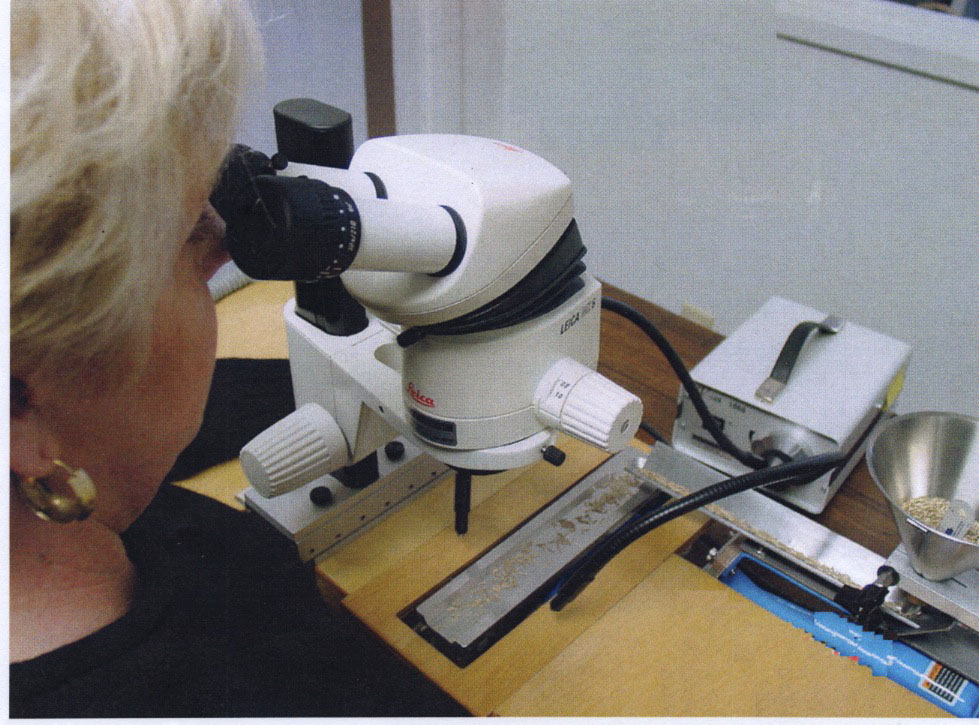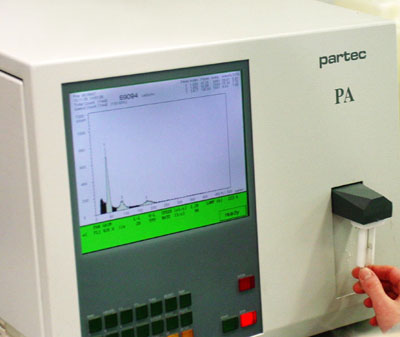It is hard to know what might have been in the mind and heart of Professor George Hyslop and others when he started the Oregon State University Seed Laboratory in 1909 in a small room in the Agronomy wing of what was to become the Agriculture Hall. He started with a crank operated divider, a blower with airflow regulated by a screw valve, and a few water-cooled germinators. Now, the OSU Seed Laboratory provides services to the seed industry in the US and around the world and is accredited by the International Seed Testing Association (ISTA).


| Purity testing with the traditional purity board in 1960. | Purity testing with the Ergonomic Purity Station in 2009. |
When Professor Hyslop first started his lab, it was a time when there were very few seed laboratories in the nation and the Oregon Seed Industry was still in its infancy. When people talked about seeds in those days, it was usually in regards to wheat and potato seeds. Looking ahead to the next 100 years, it would have been impossible to imagine the breadth, depth, and dynamism of the seed industry in Oregon and the nation, but they surely had a vision.
A hundred years later, Oregon is the leading grass seed supplier in the world and is known as the “grass seed capital of the world”. It ships seed across the country, to Europe, Asia, and South America. Needless to say, the OSU Seed Lab was not content to watch the events from the fences; rather it worked shoulder to shoulder with its seed communities both in good and difficult times. It made every possible effort to develop useful methods, organize educational services, and provide testing services to a dynamically growing agricultural community. After Seed Certification was established in 1916 and fully vested in 1937, the Seed Lab provided a testing service that was critical for certification tagging. Through the efforts of the Oregon Seed Growers League, the OSU Seed Lab moved to the Quonset Huts (brought in from what was then the Army military base ‘Camp Adair’) in 1945. In 1989, the Seed Lab moved again to its current modern building located on Campus Way. These changes made it possible to respond to the growing demand for testing and to accommodate newer and more modern equipment for testing.


| The Quonset Hut was the lab's home for many years. | Our current facility on Campus Way. |
Looking back at its first 100 years, it is clear to see that there are many contrasts between seed testing in 1909 and now. The laboratory started by providing purity and germination tests to its customers. Today, there are many more tests in various areas of seed quality to serve the needs of today's dynamic seed industry. In the purity area, the OSU Seed Lab offers regular purity testing for a wide range of crops and native species as well as US, Australian, and Canadian crop and weed exams; noxious weed exams; pest and disease, soil, undesirable grass seed, and sod quality exams. The lab also offers testing to detect Orobanche species in red clover, and noxious weeds in compost, birdseed, and animal feed. Other tests include germination, viability by tetrazolium, fluorescence, grow-outs, seed moisture content, seed weight, vigor tests, ploidy by cytometry, immunoblot assay to detect endophyte in seeds, Clearfield® bioassay, and varietal identification. In addition, special seed testing studies, research, and consultation are available based on customer needs.


| Germination facilities in 1960. | Climate controlled chambers in 2009. |






| OSU Seed Laboratory providing workshops and training services. | |
| OSU Seed Laboratory used the chromosome counting method in the past. | Ploidy by cytometry was introduced as an alternative method to the chromosome count. |
| Office work in 1948 using typewriters. | Office work in 2009 using computers with a custom database and software program. |
Highly committed people led this lab to become one of the leading labs in the nation. They were Norma Waddle (1910-17), Grace M. Cole (1917-19), Agnes Ryder (1919-22), Bertha C. Hite (1922-29), Leatha D. Bunting (1929-30), Grace Cole Fleischman (1930-38), Louisa Kanipe Jensen (1938-68), Ed Hardin (1968-80), Rodger Danielson (1980-96) Adriel Garay (1997 to 2016), and David Stimpson (2016-present).
The contributions the Seed Lab has made over the years would not have been possible without the support from a broad community. This includes seed growers, cleaners, and dealers that trust this lab to test their samples, the agricultural community and other seed users who use our test reports to determine the quality of seed they are planting the seed laboratory communities who work with us shoulder to shoulder and the scientists and professionals who challenge and stimulate new concepts and methods. Finally, thanks to all the analysts who provide tender, loving care and dedicate attention to each and every sample tested.